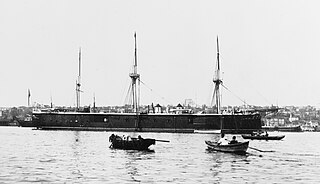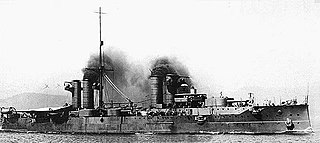
SMS Goeben was the second of two Moltke-class battlecruisers of the Imperial German Navy, launched in 1911 and named after the German Franco-Prussian War veteran General August Karl von Goeben. Along with her sister ship, Goeben was similar to the previous German battlecruiser design, Von der Tann, but larger, with increased armor protection and two more main guns in an additional turret. Goeben and Moltke were significantly larger and better armored than the comparable British Indefatigable class.

Spetsai was a Greek ironclad battleship of the Hydra class that served in the Royal Hellenic Navy from 1890 until 1920. She was named after the Saronic Gulf island of Spetses, which played a key role in the war at sea during the Greek War of Independence. Spetsai she was ordered in 1885 in response to a crisis in the Balkans and Ottoman naval expansion. The ship was launched in 1889 and delivered to Greece by 1902. She was armed with a main battery of three 10.8 inches guns and five 5.9 inches guns, and had a top speed of 17 knots.

Hydra was an ironclad warship of the Greek Navy, named for Hydra, one of the Saronic Gulf islands which played a key role in the war at sea during the Greek War of Independence. The lead ship of her class of ironclads, she was ordered in 1885 in response to a crisis in the Balkans and Ottoman naval expansion. The ship was launched in 1889 and delivered to Greece by 1892. She was armed with a main battery of three 10.8 in (270 mm) guns and five 5.9 in (150 mm) guns, and had a top speed of 17 kn.

Psara was a steel-built ironclad warship named for one of the Aegean Sea islands that played a key role in the war at sea during the Greek War of Independence. The final vessel of the Hydra class, she was ordered in 1885 in response to a crisis in the Balkans and Ottoman naval expansion. The ship was launched in 1889 and delivered to Greece by 1902. She was armed with a main battery of three 10.8 in (270 mm) guns and five 5.9 in (150 mm) guns, and had a top speed of 17 kn.

Nafkratousa was a Thyella class destroyer that served in the Royal Hellenic Navy (1906-1921).

Mesudiye was a central-battery ironclad of the Ottoman Navy, one of the largest ships of that type ever built. She was built at the Thames Iron Works in Britain between 1871 and 1875. Mesudiye had one sister ship, though she was purchased by the Royal Navy and commissioned as HMS Superb. Her primary armament consisted of twelve 10-inch (250 mm) guns in a central armored battery.

Sfendoni was a Thyella class destroyer that served in the Royal Hellenic Navy (1907-1945). It was the second ship of that name in the Hellenic Navy, but the first destroyer-type vessel bearing the name.

Thyella was a Thyella class destroyer that served in the Royal Hellenic Navy (1907-1941). It was the first ship of that name in the Hellenic Navy.

The Aetos class were four destroyers were originally constructed for the Argentine Navy as the San Luis class. In Greek they are known as the Thiria class, after the ships' names. They were purchased by the Royal Hellenic Navy in October 1912 when the Greek government expanded its navy after losing the Greco-Turkish War of 1897 and in anticipation of the Balkan Wars. In December 1916, during World War I, three of the destroyers were seized by France and served in the French Navy until 1918, all except Panthir. They were returned to Greece in 1918. In 1924–1925, they were extensively rebuilt and continued in service into World War II, where they fought with the Allies. Leon was sunk by German aircraft at Suda Bay, Crete. The other three destroyers survived the war and were used as station ships during the Greek Civil War. They were discarded in 1946.

The Hydra class of ironclads composed three ships, Hydra, Spetsai, and Psara. The ships were ordered from France in 1885 during the premiership of Charilaos Trikoupis, as part of a wider reorganization and modernization of the Greek armed forces, which had proved themselves inadequate during the Cretan uprising of 1866. Launched in 1889 and 1890, the ships were ready for service with the Greek Navy by 1892. They were armed with a main battery of three 10.8-inch (274 mm) guns and five 5.9-inch (150 mm) guns, and had a top speed of 17 knots.

HMS Adventure was the name ship of her class of two scout cruisers built for the Royal Navy during the first decade of the 20th century. For two years after being completed in 1905, the ship was in reserve. She was commissioned in mid-1907 as a flotilla leader in the Home Fleet. When the First World War began in August 1914, she was assigned to patrol the English Channel. In mid-1915 Adventure was transferred to Irish waters to serve as the flagship there. In early 1918, the ship escorted convoys to Gibraltar before being transferred to the Mediterranean at the end of the war. She returned home in mid-1919 and was paid off. Adventure was sold for scrap in early 1920.

The Pisa class consisted of three armored cruisers built in Italy in the first decade of the 20th century. Two of these were for the Royal Italian Navy and the third was sold to the Royal Hellenic Navy and named Georgios Averof. This ship served as the Greek flagship for the bulk of her active career and participated in the Balkan Wars of 1912–1913, fighting in two battles against the Ottoman Navy. She played a minor role in World War II after escaping from Greece during the German invasion in early 1941. Influenced by communist agitators, her crew mutinied in 1944, but it was suppressed without any bloodshed. Georgios Averof returned to Greece after the German evacuation in late 1944 and became a museum ship in 1952. She is the only surviving armored cruiser in the world.

The Emanuele Filiberto was a pre-dreadnought battleship built for the Italian Navy during the 1890s. Her keel was laid down in October 1893 and she was launched in September 1897; work was completed in April 1902. She had one sister ship, Ammiraglio di Saint Bon, the lead ship of the Ammiraglio di Saint Bon class. She was armed with a main battery of four 254 mm (10 in) guns and was capable of a speed in excess of 18 knots.

Roma was an Italian pre-dreadnought battleship, laid down in 1903, launched in 1907 and completed in 1908. She was the third member of the Regina Elena class, which included three other vessels: Regina Elena, Napoli, and Vittorio Emanuele. Roma was armed with a main battery of two 305 mm (12 in) guns and twelve 203 mm (8 in) guns. She was quite fast for the period, with a top speed of nearly 21 knots.

Berk-i Satvet was a torpedo cruiser of the Ottoman Navy, the second and final member of the Peyk-i Şevket class. She was built by the Germaniawerft shipyard in Germany in 1906–07, and was delivered to the Ottoman Navy in November 1907. The ship's primary armament consisted of three 450 mm (18 in) torpedo tubes and a pair of 105 mm (4.1 in) guns, and she was capable of a top speed of 21 knots. The ship's early career was uneventful; the Italo-Turkish War of 1911–12 passed without any action of the Ottoman fleet. Berk-i Satvet saw action during the Balkan Wars of 1912–13 in the Aegean and Black Seas, against Greek and Bulgarian opponents, respectively.

The Italian cruiser San Marco was a San Giorgio-class armoured cruiser built for the Royal Italian Navy in the first decade of the 20th century. She was the first large Italian ship fitted with steam turbines and the first turbine-powered ship in any navy to have four propeller shafts. The ship participated in the Italo-Turkish War of 1911–1912, during which time she supported the occupations of Benghazi and Derna, the island of Rhodes, and bombarded the fortifications defending the entrance to the Dardanelles. During World War I, San Marco's activities were limited by the threat of Austro-Hungarian submarines, although the ship did participate in the bombardment of Durazzo, Albania in late 1918. She played a minor role in the Corfu incident in 1923 and was converted into a target ship in the first half of the 1930s. San Marco was captured by the Germans when they occupied northern Italy in 1943 and was found sunk at the end of the war. The ship was broken up and scrapped in 1949.

The Italian cruiser Vettor Pisani was the name ship of her class of two armored cruisers built for the Royal Italian Navy in the 1890s. She often served as a flagship during her career and frequently served overseas. On one of these deployments, the ship received a radio message from Peking, one of the first long-range radio transmissions to a ship. Vettor Pisani participated in the Boxer Rebellion of 1900 and the Italo-Turkish War of 1911–12, during which her admiral nearly caused a diplomatic incident with the Austro-Hungarian Empire. During World War I, her activities were limited by the threat of Austro-Hungarian submarines and she was converted into a repair ship in 1916. Vettor Pisani was stricken from the Navy List in 1920 and scrapped later that year.

The Reşadiye class was a group of two dreadnought battleships ordered by the Ottoman Empire from Britain in the 1910s. The design for the ships was based on the British King George V-class battleships, although it incorporated several significant improvements. They carried the same 13.5-inch (343 mm) main battery guns as the British ships, but their secondary battery consisted of 6-inch (152 mm) guns, compared to the British vessels' 4-inch (102 mm) pieces. The first ship, Reşadiye, was laid down in 1911 and completed in August 1914, shortly after the outbreak of World War I; she was seized by the British Royal Navy and commissioned as HMS Erin. The second ship, Fatih Sultan Mehmed, had only been ordered in April 1914 and little work had been done by the start of the war, so she was quickly broken up for scrap.
Gayret-i Vataniye originally built as SMS S168, was one of the four S138-class torpedo boats built for the German Imperial Navy, but was purchased for the Ottoman Navy during construction.
Basra was one of the four Durandal-class destroyers purchased by the Ottoman Empire from France in 1907. The ship served in the Ottoman Navy during the Italo-Turkish War, the Balkan Wars and World War I.















